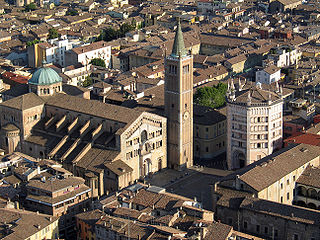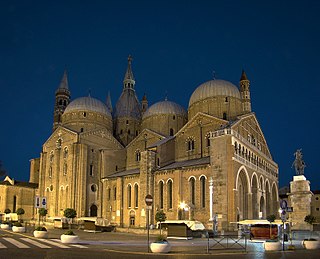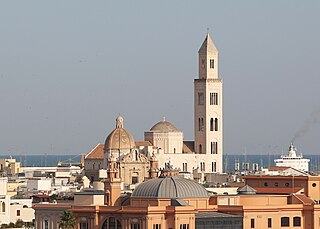
Spoleto Cathedral is the cathedral of the Archdiocese of Spoleto-Norcia created in 1821, previously that of the diocese of Spoleto, and the principal church of the Umbrian city of Spoleto, in Italy. It is dedicated to the Assumption of the Blessed Virgin Mary.

Parma Cathedral is a Roman Catholic cathedral in Parma, Emilia-Romagna (Italy), dedicated to the Assumption of the Blessed Virgin Mary. It is the episcopal seat of the Diocese of Parma. It is an important Italian Romanesque cathedral: the dome, in particular, is decorated by a highly influential illusionistic fresco by Renaissance painter Antonio da Correggio.

Cremona Cathedral, dedicated to the Assumption of the Blessed Virgin Mary, is a Catholic cathedral in Cremona, Lombardy, northern Italy. It is the seat of the Bishop of Cremona. Its bell tower is the famous Torrazzo, symbol of the city and tallest pre-modern tower in Italy.

The Pontifical Basilica of Saint Anthony of Padua is a Catholic church and minor basilica in Padua, Veneto, Northern Italy, dedicated to St. Anthony of Padua.

Vannes Cathedral is a Roman Catholic church dedicated to Saint Peter in Vannes, Brittany, France. The cathedral is the seat of the Bishop of Vannes.

Prato Cathedral, or Cathedral of Saint Stephen, is a Roman Catholic cathedral in Prato, Tuscany, Central Italy, from 1954 the seat of the Bishop of Prato, having been previously, from 1653, a cathedral in the Diocese of Pistoia and Prato. It is dedicated to Saint Stephen, the first Christian martyr.

Padua Cathedral, or Basilica Cathedral of Saint Mary of the Assumption, is a Catholic church and minor basilica located on the east end of Piazza Duomo, adjacent to the bishop's palace in Padua, Veneto, Italy.
Theonestus of Vercelli is venerated as a martyr and saint by the Catholic Church. Theonestus may have been a member of the early Christian community in Vercelli, living in an era earlier than that of Eusebius of Vercelli. Theonestus may have been a martyr, whose relics were buried in the cemetery where other Christians were buried, outside the city walls. It is believed that his whole body was conserved in the tomb dedicated to him. He is probably not the saint of the same name who was said to have been killed at Altinum by the Arians. This saint of Altinum, whose legend, in any case, is confused and contradictory, may have been confused for the martyr of Vercelli, whose historicity is more certain.

Pistoia Cathedral, or Cathedral of Saint Zeno is the main religious building of Pistoia, Tuscany, central Italy, located in the Piazza del Duomo in the centre of the city. It is the seat of the Bishop of Pistoia and is dedicated to Saint Zeno of Verona.

Pavia Cathedral is a church in Pavia, Italy, the largest in the city and seat of the Diocese of Pavia. The construction was begun in the 15th century on the site of two pre-existing Romanesque, "twin" cathedrals. The cathedral houses the remains of St. Sirus, first Bishop of Pavia, and a thorn purported to be from the Crown of Thorns worn by Christ. The marble facing of the exterior was never completed.

Faenza Cathedral is a Roman Catholic cathedral built in the style of the Tuscan Renaissance in central Faenza, Italy. It is the seat of the Bishop of Faenza-Modigliana and is dedicated to Saint Peter the Apostle.

Bari Cathedral, or Cathedral of Saint Sabinus, is the cathedral of Bari, in Apulia, southern Italy. The cathedral is the seat of the Archbishop of Bari-Bitonto, as it was previously of the archbishops, earlier bishops, of Bari. It is dedicated to Saint Sabinus, a bishop of Canosa, whose relics were brought here in the 9th century. It is senior to, though less famous than, Apulia's Basilica of St Nicholas.

The Metropolitan Cathedral of Saint Agatha, usually known as the Catania Cathedral, is a Roman Catholic cathedral in Catania, Sicily, southern Italy. It was the seat of the Bishops of Catania until 1859, when the diocese was elevated to an archdiocese, and since then has been the seat of the Archbishops of Catania.

Cagliari Cathedral is a Roman Catholic cathedral in Cagliari, Sardinia, Italy, dedicated to the Virgin Mary and to Saint Cecilia. It is the seat of the archbishop of Cagliari.

Cathedral of Saint Mary of the Assumption in Ruvo di Puglia is a Roman Catholic cathedral in Ruvo di Puglia, an historic and a City of Art in Apulia, southern Italy, dedicated to the Assumption of the Virgin Mary. Formerly the episcopal seat of the Diocese of Ruvo, it is now a co-cathedral in the Diocese of Molfetta-Ruvo-Giovinazzo-Terlizzi. The building is an important example of late Apulian Romanesque architecture, built between the 12th and 13th centuries, with several later alterations.

Ancona Cathedral is a Roman Catholic cathedral in Ancona, central Italy, dedicated to Saint Cyriacus. It is the seat of the Archbishop of Ancona. The building is an example of mixed Romanesque-Byzantine and Gothic elements, and stands on the site of the former acropolis of the Greek city, the Guasco hill which overlooks Ancona and its gulf.

Terni Cathedral is a Roman Catholic cathedral in Terni, Umbria, Italy, and the seat of the bishop of Terni-Narni-Amelia. It is dedicated to the Assumption of the Virgin Mary.

Urbino Cathedral is a Catholic cathedral in the city of Urbino, Italy, dedicated to the Assumption of the Blessed Virgin Mary. Since 1986 it has been the seat of the Archbishop of Urbino-Urbania-Sant'Angelo in Vado, and was previously the seat of the Archbishops of Urbino.

Avellino Cathedral is a Roman Catholic cathedral dedicated to the Assumption of the Virgin Mary and Saint Modestinus in Avellino, Campania, Italy. It is the seat of the bishops of Avellino.

Fano Cathedral is the principal church of Fano, Marche, Italy. Originally the seat of the bishop of Fano, since 1986 it has been the episcopal seat of the Diocese of Fano-Fossombrone-Cagli-Pergola. In January 1953 Pope Pius XII elevated it to the rank of a basilica minor.



















